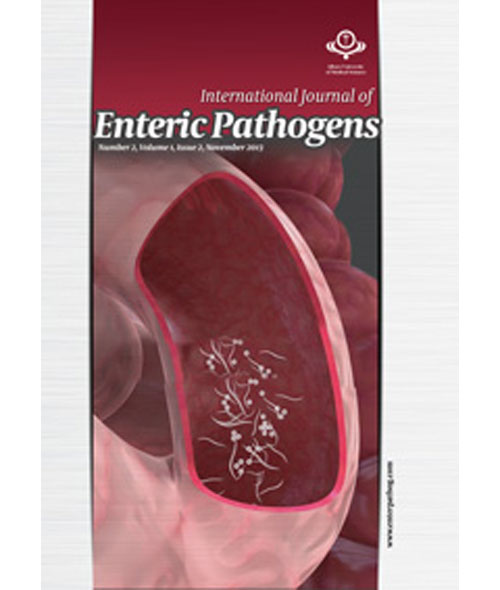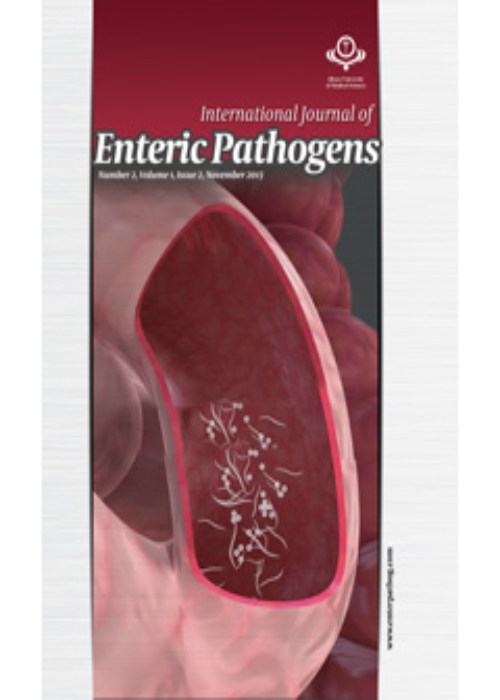فهرست مطالب

International Journal of Enteric Pathogens
Volume:7 Issue: 1, Feb 2019
- تاریخ انتشار: 1397/12/27
- تعداد عناوین: 7
-
-
Pages 1-3The second annual meeting of Clinical Case Report (CCR) has been held in Karaj, Iran from the 26th to the 27th of December, 2018 (Figure 1). The congress was organized by the Clinical Research Development Center of Shahid Rajaei Educational and Therapeutic Center, Alborz University of Medical Sciences together (Figure 2), with a Scientific Committee including some of the faculty members of the university (Table 1). The conference program was organized into the following sessions: · Cardiovascular · Nursing · Pediatrics · Obstetrics and Gynecology · Internal Medicine · Surgery · Urology · Neurology and Neurosurgery · Orthopedics · Psychiatry · Laboratory Sciences · Infectious diseases · Traditional Medicine This meeting brought together clinician and researchers from several prestigious universities and research centers throughout Iran including Rasht, Torbat Heidarieh, Qazvin, Neyshahpour, Ardebil, Isfahan, Khorramabad, Tabriz, Hamedan, Marand, Bushehr, Mashhad, Ahvaz, Sanandaj, Bojnourd, Sabzevar, Kashan, Gorgan, Ilam, Dezful, Yazd, Tehran, Urmia and Semnan, as well as leading researchers from countries such as Turkey. Participants were invited to submit scientific contributions, as oral presentations or posters. After evaluation of the 858 abstracts received, the Scientific Committee selected 40 of them for oral presentations, and accepted 231 as posters.Keywords: National Congress, Case Report, karaj
-
Pages 4-8BackgroundAvian pathogenic Escherichia coli (APEC) causes economic losses in the chicken industry worldwide.ObjectiveIn this study, virulence-associated gene profiles of APEC isolates were investigated by polymerase chain reaction (PCR).Materials and MethodsA total of 60 Escherichia coli isolates were collected from 60 colibacillosis cases from 30 broiler poultry farms in Alborz, Tehran, and Golestan provinces, Iran. After identification by biochemical tests, DNA was extracted by boiling method and 5 virulence-associated genes including: iutA, hlyF, iroN, ompT, and iss were detected by 2 multiplex PCR protocols.ResultsOf the 60 APEC isolates, 26 (43.3%) isolates had at least three virulence genes from which 12 (20%) isolates were positive for all 5 virulence genes, whereas 34 (56.6%) carried no investigated virulence genes. Presence of iutA, hlyF, iroN, ompT, and iss genes in the APEC isolates were 17 (28.3%), 17 (28.3%), 24 (40%), 26 (43.3%), and 23 (38.3%), respectively.ConclusionAccording to the results, four different virulence-associated gene profiles were seen in isolates, from which profile 1 with 12 (20%) isolates was predominant. These findings were in agreement with the previous reports.Keywords: Colibacillosis, Virulence genes, Avian pathogenic Escherichia coli
-
Pages 9-14BackgroundEnterococcus spp. are resistant to many antimicrobials including vancomycin. They may be found in foods and water.ObjectiveIn the current study, van genes were investigated in vancomycin resistant enterococci (VRE) isolated from dried vegetables in Tehran, Iran.Materials and MethodsIn this study, 140 dried vegetable samples were collected from local retailers in Tehran, Iran, 2015. Bacteria were isolated using culture, biochemistry and molecular methods. Susceptibility of the enterococcal isolates was assessed to six antibiotics of ampicillin, chloramphenicol, erythromycin, gentamicin, tetracycline and vancomycin using Kirby-Bauer method. The prevalence of vanA, B, C, D, E genes was molecularly studied in VRE using polymerase chain reaction (PCR) and sequencing techniques.ResultsOf 140 dried vegetable samples, Enterococcus spp. strains were isolated from 84 samples (60%). Totally, 48% of the isolates were resistant to vancomycin. Of 41 vancomycin-resistant enterococcal isolates, vanA was found in 23 (56.1%), vanB in 8 (19.5%) and vanC in 2 (4.9%) isolates. No vanD or vanE was found in the isolates. Results have shown a high rate of contamination with Enterococcus spp., especially VRE, in dried vegetables in Tehran.ConclusionTherefore, further hygienic regulations such as personal training and food processing, transportation, storage and marketing must be routine in food industries and local retailers.Keywords: Enterococcus spp, vancomycin, van genes, dried vegetables, antibiotic resistance
-
Pages 15-18BackgroundOne of the most important parasitic diseases in human is cystic echinococcosis (CE) which is caused by the larval stage of Echinococcus granulosus. The disease is a health problem in the Middle East countries such as Iran.ObjectiveThe aim of this study was seroepidemiological evaluation of human CE using antigen B by ELISA technique in patients referred to Baqiyatallah Hospital, Tehran, Iran.Materials and MethodsA total of 909 serum samples were randomly prepared in the central laboratory. Antigen B was extracted from sheep hydatid cyst fluid (HCF). All serum samples were evaluated by indirect ELISA and the suspected cases were rechecked. Demographic characteristics were collected by a questionnaire and cut-off was calculated as X±2SD.ResultsIn the present study, 0.8% of the collected samples were seropositive by ELISA technique. Of the 909 participants, 498 (with 1% positive response) and 411 (with 0.49% positive response) were female and male, respectively. The majority of the cases were the employee and retired military personnel (with 1.05% positive response). The most frequent age ranges were 50-59 and 70-79 with 28.57% positive response in each and in participants with academic education (85.72%). There was no statistically significant association between hydatid cyst and variables evaluated in this study.ConclusionOur results showed a low seroprevalence of human CE. It may be related to the lifestyle of people following the improvement in public health specially in urban communities.Keywords: Seroepidemiological, Hydatid cyst, Antigen B, EIZA, Baqiyatallah hospital
-
Pages 19-22BackgroundVarious animal excrements have been used as a medicine for the treatment of different diseases in the past. Today, people still use some of these excrements, especially female donkey dung (Anbarnasara,) by smelling the smoke of burnt dung for some ailments like sinusitis and bronchitis. Recently, some studies have focused on the therapeutic activities of Anbarnasara but no one has studied the active ingredients of it.ObjectiveThe aim of this study was to identify the chemical constituents and antibacterial activities of Anbarnasara and its smoke.Materials and MethodsFemale donkey dungs were collected from Shahreza in May 2017. The substance was burnt and the smoke was led to a beaker of methanol by a distillation apparatus. Then, the methanolic extract was dried via a rotary evaporator. Antibacterial activity of the smoke and also the total methanolic extract of Anbarnasara were tested on Staphylococcus aureus and Escherichia coli via well diffusion method. Chemical constituents were analyzed through gas chromatography-mass spectrometry (GC–MS) .ResultsThe results showed that Anbarnasara and its smoke have a very weak antibacterial activity. Regarding chemical constituents, both total methanolic extract and smoke extract predominantly contained toluene, xylene, and dibutyl phthalate.ConclusionPrevious studies showed xylene as one of the major components of the smoke of Anbarnasara. These articles also reported the presence of some plant-based compounds such as glyoxal, syringol, and limonene in the smoke. The presence of these compounds is probably due to the donkeys’ diet. In our study, the presence of dibutyl phthalate, an industrial plasticizer, among the components is probably due to environmental factors. These evidences suggested that Anbarnasara is under the influence of environmental factors like vegetation and pollutions and therefore, should be used as a medicine with caution. Recent claims regarding the antibacterial, cytotoxic, and wound healing activities of Anbarnasara should be considered independent of these environmental factors.Keywords: Female donkey dung, Anbarnasara, Medicinal smoke, Xylene, Toluene
-
Pages 23-26BackgroundCryptosporidium species are coccidian parasites that cause gastrointestinal disorders in humans and other animals worldwide.ObjectiveThe aim of this study was to demonstrate the rate of contamination with Cryptosporidium spp. oocysts in soils collected from public parks, primary schools, green areas, kindergartens, suburban areas, streets, residential complexes, backyards and a passenger terminal in Yazd, central Iran.Materials and MethodsThis cross-sectional study was conducted from September 2014 to February 2015, and the samples were collected from 9 different study sites and 56 regions. Soil samples were investigated by flotation technique and modified Ziehl–Neelsen staining for Cryptosporidium spp. oocysts. Finally, the slides were examined with a light microscope. The data were analyzed using SPSS software version 20.0 and chi-square statistical test.ResultsOf a total of 220 soil samples, 47 (21.36%) were found to contain Cryptosporidium spp. oocysts. Statistical analysis showed that there was no significant difference between the contamination rate and different study sites in Yazd, central Iran (P > 0.05). The highest contamination rate was observed in public parks (38.3%) and the lowest in passenger terminal, kindergartens and streets (4.25%) (P = 0.934).ConclusionThe results of the present study show that the contamination of soil with Cryptosporidium spp. can be considered a serious problem in Yazd, central Iran. It should be considered particularly in public parks.Keywords: Cryptosporidium, Soil, Contamination, Yazd, Iran
-
Pages 27-29BackgroundCystic echinococcosis is a main zoonotic infection. It can cause serious clinical problems for human health around the world. Genotypic specification of Echinococcus granulosus in human is important due to control and prevention programs.ObjectiveIn this investigation, genetic characteristics of human isolates of E. granulosus in Karaj, Iran, were studied.Materials and MethodsIn this review, 3 isolates of surgically removed hydatid cysts were obtained from patients in Shahid Madani hospital, Karaj, Iran in 2014. DNA was extracted from the protoscolex of the cyst, and polymerase chain reaction (PCR) assay was done on the COX1 gene.ResultsDNA fragments were sequenced and the results were aligned and analyzed. Among the isolates, 3 (100%) were E. granulosus (G1) strain.ConclusionThe G1 genotype was the most superior strain from human isolates of hydatid cyst in Karaj.Keywords: COX1, Genotype, Human Hydatid Cyst, Karaj


